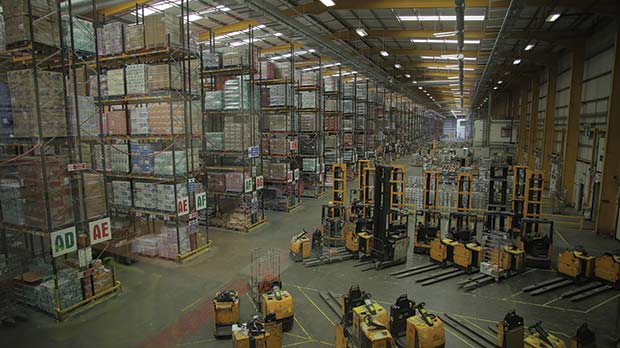Agility in distribution has become more important than ever as retailers strive to succeed in today’s multi-modal, highly volatile supply chain environment. Consumers have become more demanding, expecting improved product freshness, quality and availability through a variety of channels. At the same time, retailers are looking for ways to accommodate consumer requirements while reducing distribution overheads. The increased use of central and regional distribution centres and regional consolidation centres along with improved supplier capabilities opens the door for alternative methodologies such as pick-byline.

What is pick-by-line?
Pick-by-line has its roots in the grocery industry in the UK in the 1980’s. However, its application has extended into many markets and industry verticals throughout the world.
Pick-by-line is also known as “crossdistribution” or “case cross-dock”, among other terms. True cross-dock is a term that defines the method used to handle product which is delivered by the supplier (often prepicked by the supplier to individual store requirements) and, upon delivery to the warehouse, quite literally “crosses the dock” to join product selected in the warehouse and/or other cross dock deliveries destined for the customer. Pick-by-line is a variation on true cross-dock and includes a step to break down received pallets, distributing required cases into customer delivery containers (for example pallets or roll cages) which are laid out in a grid on the warehouse floor.
Often suppliers have minimum order requirements at the product and/or order level. As such, what is planned to be a stockless operation sometimes still carries over residual stock which is the first to be selected using standard FIFO rules.
Many Uses for Pick-by-line
The pick-by-line method was originally used with short-life product. The physical attributes of a large sub-set of short-life product, produce, mean that it does not lend itself to automation and, with this product, the least amount of handling possible is always preferable. Finally, time is critical when delivering produce to the store; the sooner the product is presented on the shop floor, the fresher and more attractive it will be when presented to the customer.
Other types of product for which pick-byline has been found preferable to the traditional pick-by-store method include promotional goods and/or seasonal goods. Both pick locations and reserve locations are often at a premium in many warehouses making it difficult to find extra capacity in the racking to house and handle promotional or seasonal goods. In addition, these goods often move quickly through the distribution centre to the customer and are widely ordered by all customers. Significant travel time can be saved by sending such products to the pick-by-line grid to service all customers, rather than travelling through the warehouse with potentially significant additional travel time to visit relevant pick locations.
The distribution of high value goods can also benefit from pick-by-line. Rather than tie up finances in each regional distribution centre holding adequate stock levels of highvalue goods, it might be preferable to maintain a centralised stock-holding of such goods, sending the product in bulk to regional warehouses where it can be picked along with other case cross-dock product for onward delivery to the customer. Safety stock levels for such products can be significantly reduced using this approach.
Managing the Workload
Pick-by-line can provide significant savings in the cost of warehousing goods. The need for the racking, equipment and labour required to store, put away and let down product is removed or significantly reduced. However, the operation itself can be labourintensive, as a large number of picks must be performed in a short amount of time. To help alleviate the impact of peaks and troughs of activity created by seasonal/promotional activity in a stocked environment, using a delayed shipment functionality within your WMS means the product can be picked into customer containers prior to normal delivery dates and selected containers may be stored until a specified date when they will be let down to join the rest of the customer delivery.
Having flexible functionality within a WMS, that will allow for pick-by-line functionality to be activated as needed for specific products is crucial. Often, promotional or seasonal goods are initially dispatched to customers through a predetermined set of central allocation/distribution orders. These goods may then be re-ordered on an as-needed basis by the stores. With this in mind, a promotional section of goods may be set up as pick-by-line for the initial delivery, perhaps with delayed shipments activated for chosen customers. After the initial receipt and pickby- line processing, residual stocks may be put away and products housed in the main body of the warehouse for on-going ad hoc orders by the customer. Likewise, the warehouse can meet sudden widespread demand for a specific product by allocating it to the pick-byline section where the goods may be picked with the rest of the warehouse’s pick-by-line goods.

Benefits
Strategic use of pick-by-line can offer a number benefits.
– Reduced/eliminated need for warehouse racking provides cost savings and allows for quick start-up time
– Reduced/eliminated need for forklift trucks and drivers
– Labour savings on putaway, counting, travel time
– Frees up finances held in stockholding Other Considerations
The re-order process for traditional stockless pick-by-line items has requirements that differ from stocked items. A Short Cycle Ordering facility will generate supplier orders based on customer demand, taking into account any residual stocks from previous orders. Based on system parameters, orders may be flagged for approval or sent to the supplier automatically. Where customer demand exceeds what the supplier is able to deliver in the agreed lead time, Short Cycle Ordering will allow the re-order buyer to spread the demand across multiple suppliers who provide the same or similar goods. This is particularly applicable to the situation in which the warehouse has multiple suppliers who provide short life product such as produce and fresh meat.
Conclusion
Pick by line offers businesses the ability to react quickly to customer demand, whilst maintaining or reducing overheads. As retailers grapple with the increasing demands on the distribution centre, using methodologies that improve logistics is compelling.
WCS
01276 410144




Comments are closed.